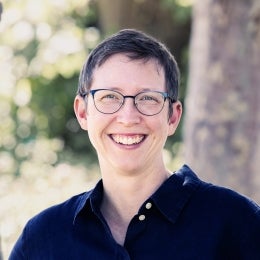
In celebration of Open Access Week 2025 (October 20-26), the UCSB Library spoke with Kate McDonald, Associate Professor in the History Department, about publishing her book Placing Empire: Travel and the Social Imagination in Imperial Japan open access.
The UCSB Library is committed to participating in UC initiatives to support a sustainable open-access publishing model for UCSB authors.
Can you tell us about the book you published and what inspired you to write it?
I ended up writing about tourism in the Japanese Empire in a roundabout way. I had initially wanted to write something about trains and Japanese imperialism (I am a bit of a train nerd). In my search for primary sources, I kept coming across tourist guidebooks for Korea, Taiwan, and Manchuria. The guidebooks were published in the 1910s, 1920s, and 1930s by the Japanese colonial governments, and they were written in Japanese for Japanese travelers. There were so many of them! All of these places were under Japanese colonial rule. Korea and Taiwan were formal colonies. Southern Manchuria was an informal colony until 1932, when the Japanese military in Manchuria established the puppet state of Manchukuo. I wondered, why were these colonial governments so interested in tourism? How did these guidebooks represent colonized lands to imperial travelers? I ended up writing a book about tourism and the spatial politics of Japanese imperialism. It is called Placing Empire: Travel and the Social Imagination in Imperial Japan and it came out from University of California Press in 2017.
Why did you decide to publish your book as open access?
I wanted to publish the book as open access mainly because I wanted people to read the book! I wanted to be in conversation with scholars and students in Japan, Korea, China, and Taiwan. I also wanted to be in conversation with scholars of tourism who worked outside of the United States. Most U.S. academic presses don’t have robust distribution networks outside of the United States. But with open access, I could guarantee that my book was accessible to readers everywhere. As a consequence, it was reviewed in Japanese and Korean language journals and assigned in graduate courses in Asia and Europe. I’ve been so glad to receive emails from faculty and students around the world, some of which explicitly tell me open access made it possible for them to access the book or assign it to their classes.
What was the publishing process like for an open access book?
The publishing process was the same for open access as it would have been for a traditionally licensed book. It was double blind peer-reviewed and reviewed and approved by the UC Press editorial board.
How do you think open access publishing fits within your discipline or department? Is it gaining more acceptance?
My discipline does not differentiate between open access or traditional publication. The quality of the venue is what matters, not the access model.
Have you been able to track usage statistics or downloads? What have you learned?
The UC Press website tracks views and downloads. It was gratifying to see how many times the entire book had been downloaded! At the same time, I’ve learned not to pay too much attention to the download statistics. The number of reviews and citations are more important.
What advice would you offer to colleagues interested in publishing open-access articles?
I would say, go for it! It is a great way to make your work out there, especially if you want to be in conversation with scholars and students from all over the world.
What changes would you like to see in the future of academic publishing, particularly for monographs?
I would like to see presses better support the editorial staff they have. Authors never work alone. For example, I benefited tremendously from the excellent questions and corrections I received from my copyeditor at UC Press. I would also like to see more support from journals and universities to more narrowly delimit publishing agreements so that authors aren’t forced to allow presses to license their work to third parties (or, worse, use it to train generative AI).


